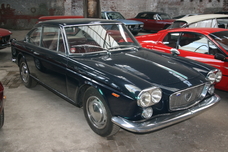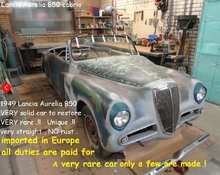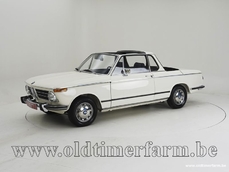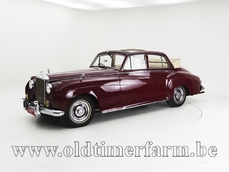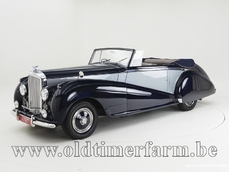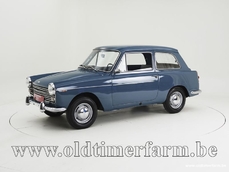Lancia Flavia Cabriolet Vignale 1.5 '63 1963
General description :
Very rare Fully restored : file and invoices original coour roadworthy, perfect condition The Lancia Flavia is the basis of a new era of creativity and technology. It is a luxury car like all Lancias. It made its appearance at the Turin Motor Show in 1960 and was produced until 1971. The Lancia Flavia did not replace any other model, it entered the restricted circle of large road cars of the 1960s. The Flavia is conceived by the engineer Antonio Fessia, trained at Fiat, and who has been part of Lancia since it was taken over by Carlo Pesenti, a cement industry magnate. He equips the Flavia with front-wheel drive, which he has already experienced on the very rare Caproni Cemsa from 1947, a 1,100 cc car, produced in ten copies! Fessia therefore designed an entirely new automobile, which became Lancia's commercial showcase. In addition to the sedan, Lancia produces a splendid Pininfarina coupe, and a magnificent Vignale convertible bodied by Michelotti. Another sport model is made by Zagato, who also participates in sporting events. From 1968, the Flavia will also be equipped with an 1800 cc, and finally a 2000 cc in 1969. The Carrozzeria Vignale was created in 1948 by Alfredo Vignale. Vignale had worked at Stabilimenti Farina, which later became Pininfarina. He mainly worked for Maserati, Ferrari, Fiat and Lancia. Some of its achievements have become legendary, such as the Maserati 3500 GT and the Maserati Mexico. Vignale has also collaborated with Triumph and the Czech manufacturer Tatra. From 1969, Vignale was taken over by the Argentinian pilot and manufacturer Tomaso, already the owner of Ghia. Specifications Bodywork Length : cm (in): 434 (171) Width : cm (in): 161(63.4) Height : cm (in): 137 (53.9) Wheelbase : cm (in) : 248 (97.6) Weight: kg (lb) : 1150 Mechanics. Displacement : flat-four 1500 cc (91.5 cu in), front-mounted Valve gear : 8 Fuel system : 2 Solex carburettors Gearbox : 4-speed manual Drive wheels : rear-wheel drive LHD Maximum power : 89 hp at 5800 rpm Maximum torque : 116 Nm at 4500 rpm Maximum speed : 171 km/h (106 mph)
http://www.oldtimerfarm.be/en/collection-cars-for-sale/5330/lancia-flavia-cabriolet-vignale-15-63.php
1963 Lancia Flavia Cabriolet Vignale 1.5 '63 is listed sold on ClassicDigest in Aalter by Oldtimerfarm Dealer for €48950.
Car Facts
Car type : Car Make : Lancia Model : Flavia Model Version : Cabriolet Vignale 1.5 '63 Engine size : 0.0 Model Year : 1963 Location : Aalter
Sold
Seller Information
Sold
People who viewed this Lancia Flavia also viewed similar Lancia listed at ClassicDigest
Other cars listed for sale by this dealer
About Lancia
Ah, Lancia, the Italian marque that danced on the edge of automotive brilliance! Let me take you on a journey through the captivating story of Lancia, a brand that embodies passion, innovation, and rallying prowess.Act 1: The Early Years (1906-1920s)
Lancia was founded in 1906 by Vincenzo Lancia, an engineering wizard with a flair for the extraordinary. The brand quickly gained a reputation for its precision engineering and innovative approach. The Lancia Alpha, introduced in 1907, was the first car to feature a narrow-angle V4 engine, setting the tone for Lancia's commitment to technical excellence.
Act 2: Innovation at its Core (1930s-1950s)
The 1930s saw Lancia pushing the boundaries of innovation with models like the Lambda, the first car to feature a load-bearing monocoque chassis. The Aprilia, introduced in the 1930s, showcased cutting-edge aerodynamics and a V4 engine, solidifying Lancia's reputation as a pioneer.
Act 3: Post-War Elegance (1950s-1960s)
After World War II, Lancia continued to dazzle with models like the Aurelia, the first production car to feature a V6 engine. It blended performance with comfort and elegance. The Flaminia followed, embodying luxury and advanced engineering.
Act 4: Rally Domination (1970s-1980s)
Lancia etched its name in motorsport history with an unparalleled rally legacy. The Lancia Stratos, a wedge-shaped wonder, dominated the rally scene in the 1970s, clinching three consecutive World Rally Championships from 1974 to 1976. The Delta Integrale, introduced in the 1980s, continued this rally reign with multiple championships.
Act 5: Struggles and Resilience (1990s-2000s)
The latter part of the 20th century brought financial challenges for Lancia, leading to collaborations with other automakers. Despite the difficulties, Lancia introduced models like the Thesis and the Ypsilon, showcasing its commitment to style and substance.
Act 6: 21st Century Reinvention (2010s-Present)
In the 2010s, Lancia faced a shift in strategy, focusing on the Ypsilon as its primary model. While production numbers dwindled, the brand maintained its reputation for distinctive design and comfort.
Epilogue: A Legacy of Passion and Innovation
Lancia's story is one of passion, innovation, and motorsport glory. The brand, with its groundbreaking designs, technological advancements, and rallying triumphs, has left an indelible mark on the automotive world. Lancia may have faced challenges in recent years, but its legacy lives on, celebrated by enthusiasts who recognize the magic woven into each Lancia creation. Finally, Here are some of the most important Lancia models that have left an enduring mark:
1. Lancia Lambda (1922-1931):
The Lancia Lambda is often considered a pioneering model, being the first car to feature a load-bearing monocoque chassis. This innovation set the stage for modern automotive design. The Lambda was available in various body styles and showcased Lancia's commitment to engineering excellence.
2. Lancia Aurelia (1950-1958):
The Aurelia, introduced in the early 1950s, was a groundbreaking model for Lancia. It was the first production car to feature a V6 engine, and it incorporated advanced engineering, including a rear transaxle and inboard rear brakes. The Aurelia set new standards for performance and comfort.
3. Lancia Flaminia (1957-1970):
Continuing Lancia's tradition of combining style with innovation, the Flaminia was introduced as a luxury sedan. It featured a V6 engine, a de Dion rear suspension, and avant-garde styling. The Flaminia further solidified Lancia's reputation for producing high-end, technically advanced vehicles.
4. Lancia Stratos (1973-1978):
The Lancia Stratos is an icon in the world of rallying. Born out of Lancia's rallying ambitions, the Stratos was purpose-built for competition. With its distinctive wedge-shaped design and a mid-mounted V6 engine, it became the first car to win the World Rally Championship three times consecutively from 1974 to 1976.
5. Lancia Delta (1979-1994):
The Lancia Delta is synonymous with rally success. It dominated the rally scene in the late '80s and early '90s, winning six consecutive manufacturers' titles in the World Rally Championship. The Delta's combination of performance, agility, and versatility made it an icon both on and off the rally stages.
6. Lancia Thema 8.32 (1986-1994):
The Lancia Thema 8.32 was a performance-oriented version of the Thema sedan, and it stood out for its collaboration with Ferrari. It featured a 3.0-liter V8 engine sourced from Ferrari, making it one of the few sedans with a Ferrari powerplant. This model showcased Lancia's ability to blend luxury and performance.


















